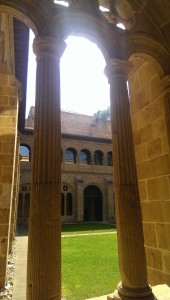Que tal, mis amigos?
When I was a junior in high school, a choir conductor I was working with introduced me to the concept that music and the arts convey the human experience in a way that is unlike any other. Since that moment, my commitment to the arts has been truly integral to my existence. Though that may sound like a bit of a cliché, it is true. Architecture, visual arts, dance, theater, literature, and music are all of the utmost importance to me, and when I found out I was going on this trip I became ecstatic about the possibilities San Sebastian had to offer in terms of new and exciting art to experience.
Between eating at a myriad of pintxos bars, visiting and enjoying the beautiful beaches, studying in our Spanish classes at Lacunza, wandering around the city (with and without tour guides), and meeting scores of new friends, we’ve been kept quite busy over the past few days. Thusly, our biggest experience thus far with the history and art of San Sebastian was today at San Telmo Museum. San Telmo Museum consists of two parts. The first part is a mid-sixteenth century convent (the original San Telmo building) built using a mix of Renaissance and Gothic styles. The convent is dedicated to the patron saint of sailors, San Telmo, from whom of course it takes its name. The second part of the building is the rest of the museum, which was designed by two modern architects, Nieto and Sobejano. The rest of the museum was designed to mimic the surrounding natural landscape (mountainous and verdurous) and has holes through which plants will eventually grow. The combination of architecture new and old is quite fascinating and in my opinion appeals to a desire for usefulness found within the basic survival instinct of animals and humans alike.
Animalistic survival instincts aside (am I getting too weird for a college blog post?), I found myself deeply moved by the original San Telmo convent. Even though I am not a particularly religious person, I was so taken by the immense size and beauty of the church’s interior that I nearly cried. Seeing the tremendous stone pillars and the high ceiling of the building stirred my imagination, and I began to consider what incredible lengths humans will go to in order to express their feelings through art. In the case of the church, the most advanced engineering and architectural skills of the time were employed to express a simultaneous love for and fear of God in the form of a building. The end result was a room that truly dwarfs its human occupants, demonstrating the greatness of God and our relative unimportance. You, like me, may not necessarily subscribe to the Christian God, but nonetheless Christianity must be taken into account when thinking about the intention behind a church.
After about twenty minutes spent in total awe of the church interior, I began talking to some classmates about the church, and eventually discovered some friends singing in the crypt under the altar. The acoustics were truly a wonder to behold. A vocal improvisation then took place between my friends and I – a divine musical experience that brought us closer together, if only for a short amount of time. As the vibrations of our final chord slowly fizzled out, we all shared a final moment of connectedness. Over the course of two more trips down to the crypt, I brought around ten total people to hear the wonderful acoustics through a short musical demonstration. Some Spanish tourists even got to hear the demonstration. This was truly meaningful to me – I was able to share my love of music and the joy it gives me with others, even though I am thousands of miles away from my home.
The rest of the museum was something that I unfortunately experienced mostly by myself. However, what I shared with others in the cathedral is something that I would not trade for any material good in the world. Art helps us to share and to better understand the human experience, no matter our religion or nationality, the languages we speak, or the experiences we’ve had in life. Though the impact the arts can have on our lives may differ between people – one person may listen to a symphony and feel great grief and wistfulness while another person may experience great joy and hope for the future – we are all changed in some capacity by the art to which we expose ourselves. Because of our artistic experiences still to come in San Sebastian, we will return to the United States healthier and more complete human beings. If growth as a person doesn’t make a study abroad experience worth it, I’d be hard pressed to find something else that could.
So please, enjoy some medium of art today. I hope that you have a wonderful and human experience in doing so.
Agur, y gracias por leer,
Eric Miller

Here’s a view of the inside of the church from the balcony. (sorry about my phone’s poor photo quality!)

The upper level of the cloister outside the church was cleverly equipped with one-way mirrors. The mirror side faced into the courtyard and created a feeling of continuity and openness in the cloister. The space behind the mirror in the walkway was therefore available for exhibits, and one could see down into the courtyard from the walkway.
